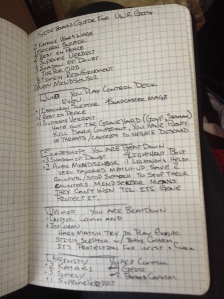I have recently tried to get in the habit of writing out my sideboards and sideboard strategies into a notebook, a larger-format Moleskin I call the Sideboard Bible. So far, I have recorded by sideobarding decisions for Eggs (R.I.P) and UWR Midrange in Modern. I have found this process to be incredibly reassuring, not to mention helpful during a tournament. Each archetype in the format is written down under that tournament’s sidebaord, along with my analysis of whether I should be the aggressor or the control. Then I write a list of cards to remove from the main deck and cards to bring in from the board. Finally, I do what, to me, is the important part of the process: I explain the match-up and the goals you have as you are playing the match.
It looks something like this:
The goal is to catalog the entire Modern format and then begin working on Legacy. For now, at least, I’m holding onto this and only handwriting it, but I may share some typed excerpts in the future. I find that when you are playing a long day of Magic having a shortcut sideboarding is one of the best ways to streamline your process.
Eventually, I think I’ll start doing this for Standard. But for the time being, I’d like to get the older formats taken care of. Standard changes so fast, it’s hard to get a grip on all the new tech and have it be relevant for long.
The other great thing about having this record is that it gives me a good idea of what my opponent may be up to post-board. That’s valuable information—knowing how a deck sides against you means you’ll be better prepared when they side in their board wipes, or you’ll remember that they removed their burn because it’s not as good against your Thragtusk. This means less stress after losing game one and more focus. Tilt is a real thing, and taking steps to avoid it can make the difference in a tight game three.
Being a Durdle Magus doesn’t just mean playing strategically in-game. Sometimes it means being prepared for the interactions just outside the game, too. Having a sideboard plan is what separates the 1-2 from the 2-1’s. Just over 60% (estimated made-up number) of tournament matches are played after sideboarding. Why aren’t you spending more time on yours?
Zac Clark, Durdle Magus


